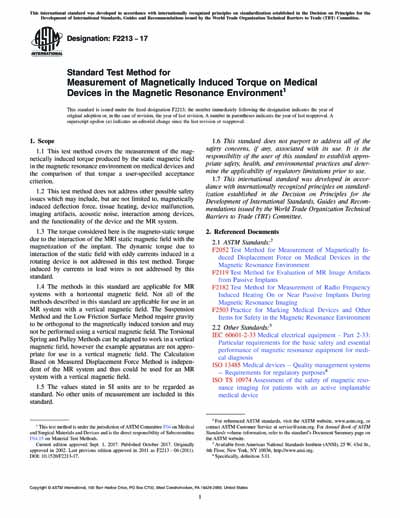Most recent
ASTM F2213-17
Standard Test Method for Measurement of Magnetically Induced Torque on Medical Devices in the Magnetic Resonance Environment
1.1 This test method covers the measurement of the magnetically induced torque produced by the static magnetic field in the magnetic resonance environment on medical devices and the comparison of that torque a user-specified acceptance criterion.
1.2 This test method does not address other possible safety issues which may include, but are not limited to, magnetically induced deflection force, tissue heating, device malfunction, imaging artifacts, acoustic noise, interaction among devices, and the functionality of the device and the MR system.
1.3 The torque considered here is the magneto-static torque due to the interaction of the MRI static magnetic field with the magnetization of the implant. The dynamic torque due to interaction of the static field with eddy currents induced in a rotating device is not addressed in this test method. Torque induced by currents in lead wires is not addressed by this standard.
1.4 The methods in this standard are applicable for MR systems with a horizontal magnetic field. Not all of the methods described in this standard are applicable for use in an MR system with a vertical magnetic field. The Suspension Method and the Low Friction Surface Method require gravity to be orthogonal to the magnetically induced torsion and may not be performed using a vertical magnetic field. The Torsional Spring and Pulley Methods can be adapted to work in a vertical magnetic field, however the example apparatus are not appropriate for use in a vertical magnetic field. The Calculation Based on Measured Displacement Force Method is independent of the MR system and thus could be used for an MR system with a vertical magnetic field.
1.5 The values stated in SI units are to be regarded as standard. No other units of measurement are included in this standard.
1.6 This standard does not purport to address all of the safety concerns, if any, associated with its use. It is the responsibility of the user of this standard to establish appropriate safety, health, and environmental practices and determine the applicability of regulatory limitations prior to use.
1.7 This international standard was developed in accordance with internationally recognized principles on standardization established in the Decision on Principles for the Development of International Standards, Guides and Recommendations issued by the World Trade Organization Technical Barriers to Trade (TBT) Committee.
Content Provider
ASTM International [astm]






